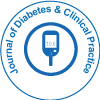Nosso grupo organiza mais de 3.000 Séries de conferências Eventos todos os anos nos EUA, Europa e outros países. Ásia com o apoio de mais 1.000 Sociedades e publica mais de 700 Acesso aberto Periódicos que contém mais de 50.000 personalidades eminentes, cientistas de renome como membros do conselho editorial.
Periódicos de acesso aberto ganhando mais leitores e citações
700 periódicos e 15 milhões de leitores Cada periódico está obtendo mais de 25.000 leitores
Indexado em
- Google Scholar
- Publons
- ICMJE
Links Úteis
Diários de acesso aberto
Compartilhe esta página
Abstrato
Diabetic Nephropathy in Pregnancy and Derived Metabolites Inmodulation
Eunyong Kim
The main cause of kidney disorders that are at their final stages is diabetic renal disease, which is a growing public health burden. Host-gut microbiota interactions have become increasingly important for maintaining host homeostasis in recent years. There is growing evidence for a bidirectional microbiota-kidney interaction in the setting of nephropathies, which is particularly noticeable with progressive kidney dysfunction [1]. In fact, chronic kidney disease alters the "healthy" microbiota structure, causing intestinal microbes to produce large amounts of uremic solutes that damage the kidneys [2]. On the other hand, the uremic state, fuelled by decreased renal clearance, causes changes in microbial metabolism and composition, creating a vicious cycle in which dysbiosis and renal dysfunction worsen over time [3]. We shall synthesise the data from clinical and experimental research in this review [4]. Since the previous several decades, there has been a marked increase in the frequency of both type 1 and type 2 diabetes worldwide, which has resulted in a significant increase in the prevalence of micro- and macrovascular complications [5]. The most frequent microvascular consequence and the main cause of end-stage renal disease, diabetic kidney disease, are thought to develop in 30 to 40% of diabetic individuals. Angiotensin II receptor blockers and angiotensin-converting enzyme inhibitors, along with novel glucose-lowering medications like sodium-glucose transporter 2 inhibitors, have been shown to be effective in the traditional treatment of DKD. This has been shown to reduce diabetes-related cardiovascular morbidity and slow the progression of CKD in T2D patients [6]. However, the continued danger of developing ESKD is considerable, calling for the development of and strategies to effectively treat DKD or stop its resurgence [7]. Modifying kidney inflammation and the gut-kidney axis may be attractive therapeutic targets to stop DKD from developing into ESKD, for which renal transplantation is the only effective treatment [8]. Trillions of bacteria that coexist with the host in the digestive system, especially the large intestine, are housed there [9]. The native microorganisms supply the host with crucial metabolites through the bacterial manufacture of vitamins, secondary bile acids, and metabolism of food proteins and carbohydrates, while the host ensures an anaerobic habitat and nourishment for the microbiome [10].
Diários por Assunto
- Agro e Aquicultura
- Alimentação e Nutrição
- Bioquímica
- Ciência da Computação
- Ciência de materiais
- Ciencias ambientais
- Ciências Clínicas
- Ciências Farmacêuticas
- Ciências gerais
- Ciências Médicas
- Ciências Sociais e Políticas
- Ciências veterinarias
- Economia e Contabilidade
- Enfermagem e cuidados de saúde
- Engenharia
- Engenheiro químico
- Física
- Genética e Biologia Molecular
- Geologia e Ciências da Terra
- Gestão de negócios
- Imunologia e Microbiologia
- Informática
- Matemática
- Química
Revistas clínicas e médicas
- Anestesiologia
- Assistência médica
- Biologia molecular
- Cardiologia
- Cirurgia
- Dermatologia
- Diabetes e Endocrinologia
- Doenças infecciosas
- Enfermagem
- Fisioterapia e Reabilitação
- Gastroenterologia
- Genética
- Hematologia
- Imunologia
- Medicamento
- Medicina Reprodutiva
- Microbiologia
- Nefrologia
- Neurologia
- Odontologia
- Oftalmologia
- Oncologia
- Ortopedia
- Pediatria
- Pesquisa Clinica
- Pneumologia
- Psiquiatria
- Toxicologia

 English
English  Spanish
Spanish  Chinese
Chinese  Russian
Russian  German
German  French
French  Japanese
Japanese  Hindi
Hindi